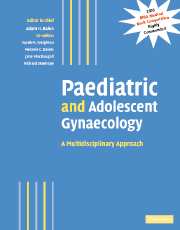Book contents
- Frontmatter
- Contents
- Contributors
- Preface
- Part I Normal development
- 1 Embryology of the female genital tract
- 2 Molecular genetics of gonad development
- 3 Gonadotrophin receptors
- 4 Normal childhood, puberty and adolescence
- 5 Control of the menstrual cycle and fertility
- 6 Nutrition and reproductive function
- 7 Normal bladder control and function
- 8 Development of sexuality: psychological perspectives
- Part II Management of developmental abnormalities of the genital tract
- Part III Management of specific disorders
- Index
- Plate section
- References
8 - Development of sexuality: psychological perspectives
from Part I - Normal development
Published online by Cambridge University Press: 04 May 2010
- Frontmatter
- Contents
- Contributors
- Preface
- Part I Normal development
- 1 Embryology of the female genital tract
- 2 Molecular genetics of gonad development
- 3 Gonadotrophin receptors
- 4 Normal childhood, puberty and adolescence
- 5 Control of the menstrual cycle and fertility
- 6 Nutrition and reproductive function
- 7 Normal bladder control and function
- 8 Development of sexuality: psychological perspectives
- Part II Management of developmental abnormalities of the genital tract
- Part III Management of specific disorders
- Index
- Plate section
- References
Summary
In biomedicine, there are morphological and biochemical characteristics that can be measured with varying degrees of accuracy, rendering it more possible to describe variations in physical development and to define typical ranges. Sexuality dimensions, by comparison, afford no such luxury. “Normal” sexuality is contentious — in psychology and in society — and is destined to remain so.
What do psychologists have to say about human sexuality and its development? Why do some psychologists test children for “gender-appropriate” toy preferences, while others “un-define sex differences”? The simple answer is that they subscribe to different theoretical viewpoints, ask different questions and use different research methods to address their questions. The aim of this chapter is to describe and discuss key psychological perspectives in sexuality development. It is not possible to be a neutral presenter of rival positions, so I should make explicit my own biases. While I have come from a positivist framework and still apply that knowledge in selective projects, I have found that this framework alone is not adequate for examining and addressing sexuality events that are presented to me in clinical settings. My current view is that individual sexuality events cannot be understood without reference to cultural representations of such events. I hope it becomes clear why many psychologists now find it important to integrate discursive analysis in sexuality studies.
- Type
- Chapter
- Information
- Paediatric and Adolescent GynaecologyA Multidisciplinary Approach, pp. 77 - 94Publisher: Cambridge University PressPrint publication year: 2004
References
- 2
- Cited by



